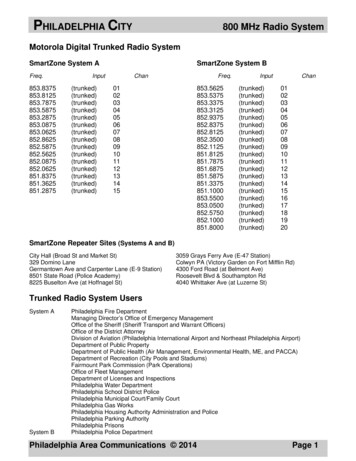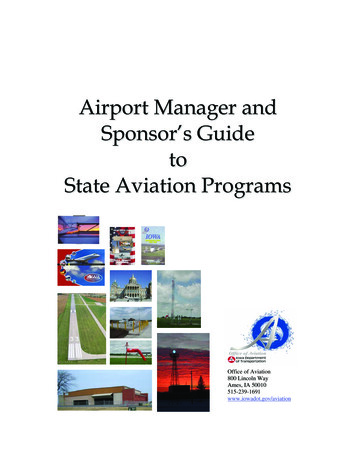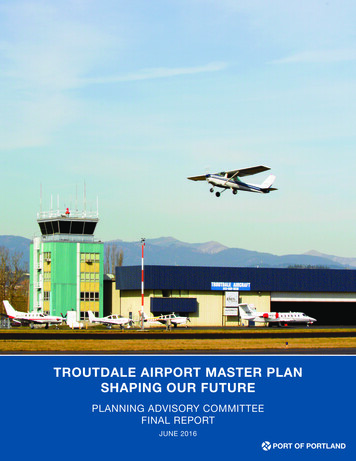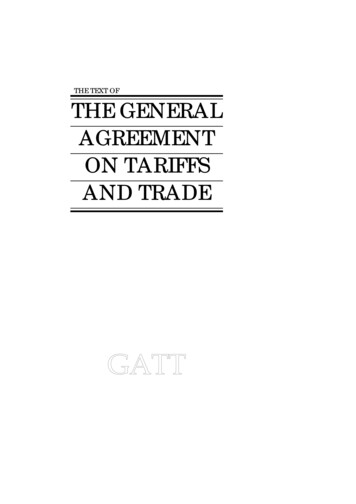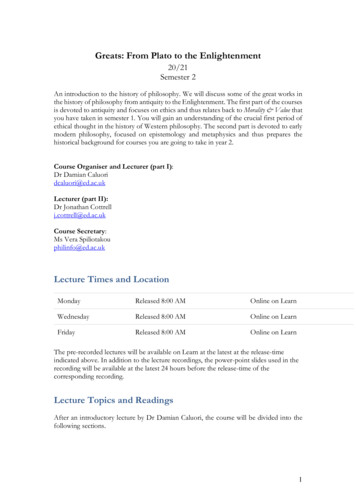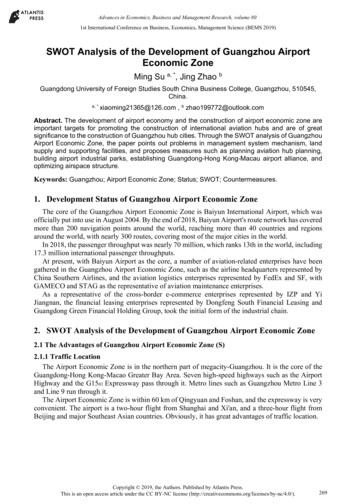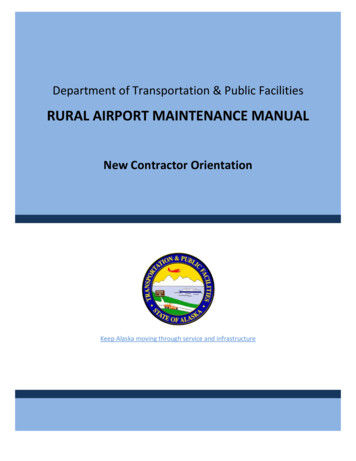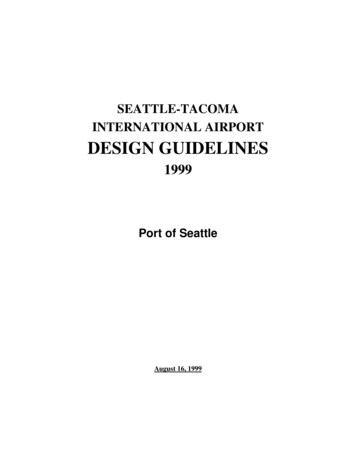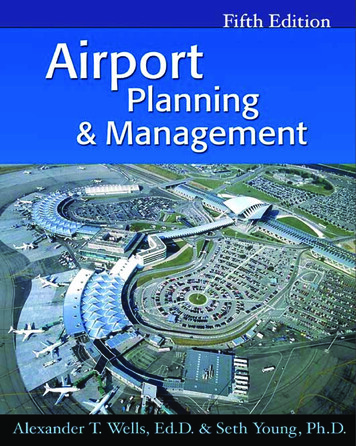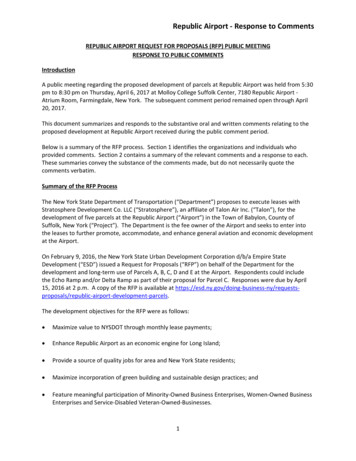
Transcription
Republic Airport ‐ Response to CommentsREPUBLIC AIRPORT REQUEST FOR PROPOSALS (RFP) PUBLIC MEETINGRESPONSE TO PUBLIC COMMENTSIntroductionA public meeting regarding the proposed development of parcels at Republic Airport was held from 5:30pm to 8:30 pm on Thursday, April 6, 2017 at Molloy College Suffolk Center, 7180 Republic Airport ‐Atrium Room, Farmingdale, New York. The subsequent comment period remained open through April20, 2017.This document summarizes and responds to the substantive oral and written comments relating to theproposed development at Republic Airport received during the public comment period.Below is a summary of the RFP process. Section 1 identifies the organizations and individuals whoprovided comments. Section 2 contains a summary of the relevant comments and a response to each.These summaries convey the substance of the comments made, but do not necessarily quote thecomments verbatim.Summary of the RFP ProcessThe New York State Department of Transportation (“Department”) proposes to execute leases withStratosphere Development Co. LLC (“Stratosphere”), an affiliate of Talon Air Inc. (“Talon”), for thedevelopment of five parcels at the Republic Airport (“Airport”) in the Town of Babylon, County ofSuffolk, New York (“Project”). The Department is the fee owner of the Airport and seeks to enter intothe leases to further promote, accommodate, and enhance general aviation and economic developmentat the Airport.On February 9, 2016, the New York State Urban Development Corporation d/b/a Empire StateDevelopment (“ESD”) issued a Request for Proposals (“RFP”) on behalf of the Department for thedevelopment and long‐term use of Parcels A, B, C, D and E at the Airport. Respondents could includethe Echo Ramp and/or Delta Ramp as part of their proposal for Parcel C. Responses were due by April15, 2016 at 2 p.m. A copy of the RFP is available at cels.The development objectives for the RFP were as follows: Maximize value to NYSDOT through monthly lease payments; Enhance Republic Airport as an economic engine for Long Island; Provide a source of quality jobs for area and New York State residents; Maximize incorporation of green building and sustainable design practices; and Feature meaningful participation of Minority‐Owned Business Enterprises, Women‐Owned BusinessEnterprises and Service‐Disabled Veteran‐Owned‐Businesses.1
Republic Airport ‐ Response to CommentsThe selection criteria for the RFP was as follows: Financial Offer (30%): Provision of competitive terms for the leasing of the proposed site. Development Concept (25%): Quality of proposal, design, sustainable building practices and useincluding consistency with allowed uses at the airport.Respondent Qualifications (20%): Experience, development skills and financial resources necessaryto complete a high‐quality project pursuant to the terms of the RFP.Schedule and Timing (10%): Proven ability to complete the project in a timely manner.Employment Impact (5%): Creation of construction and permanent on‐site jobs and payroll. Indirectjob creation through on‐site job training programs may also be considered.Economic Impact (5%): Projected expenditures, construction costs, annual operating costs andother direct spending that will help spur economic activity. The impact of indirect spending thatthe project will generate and any applicable tax revenue.Diversity Practices (5%): Respondents to the RFP will be evaluated for Diversity Practices usingthe attached Diversity Practices Scoring Matrix (see Appendix J of the RFP). Up to 5 percent will beawarded based upon the contents of the Diversity Practices Questionnaire (see Appendix J of theRFP) submitted by each Respondent to the RFP. By letter dated August 31, 2016, the Department conditionally designated Stratosphere as the developerof the Airport parcels A, B, C (inclusive of the Echo Ramp) and D and entered into a term sheet for suchparcels. Parcel E was initially conditionally designated to another developer, but that initialbidder/developer failed to provide the required non‐refundable good faith deposit for such parcel whichwas required under the RFP and subsequently also did not sign the conditional designation letter (P.6 ofthe RFP). Thereafter, by letter dated November 10, 2016, Stratosphere was conditionally designated asthe developer for Parcel E and entered into a term sheet for such parcel. Pursuant to the designationletters, the Department agreed to negotiate exclusively with Stratosphere towards the execution ofleases for the parcels pending completion of the Department’s review and determination under theState Environmental Quality Review Act (“SEQRA”).Stratosphere provides fixed base operator (“FBO”) services at Republic Airport, which include thestorage, maintenance, and temporary housing of small to mid‐sized personal, charter, and corporateplanes and jets. The Project will accommodate the organic growth of Stratosphere’s existing operationsat the Airport currently located in Hangars 6 and 7. Stratosphere has proposed to use the parcelssubject to the proposed leases, generally, as follows: Parcel A – construction of a 57,600 square‐foot storage hangar and maintenance facility, as wellas additional parking spaces.Parcel B – construction of a 67,356 square‐foot hangar with FBO/office/support areas.Parcel C – demolition of an abandoned restaurant and construction of an aircraft parking ramparea. No additional construction is proposed for the Echo Ramp.Parcel D – construction of a general aviation ramp and tie‐down area to support the relocationof small aircraft currently located at the existing Echo Ramp.Parcel E – construction of a general aviation ramp and T‐hangars for general aviation purposesas well as a tie‐down area.2
Republic Airport ‐ Response to CommentsThe Department held two public meetings on the Project. The first public hearing occurred on March 2,2017. At the March 2, 2017 meeting, the public was permitted to ask questions. Those questions andanswers were then published on Republic Airport’s website. Thereafter, a second public meeting occurredon April 6, 2017 at Republic Airport from 5:30 p.m. until 8:30 p.m. Although public comments were finishedprior to 8:30 p.m., the meeting was held open until 8:30 p.m. Written comments were accepted until April20, 2017. The Department considered these comments during its review of the Project and has consolidatedand addressed them below.3
Republic Airport ‐ Response to CommentsSection 1: List of Elected Officials, Organizations, and Individuals Who CommentedELECTED OFFICIALS1.John E. Brooks, New York State Senator – 8th Senate District ‐ oral comment (Brooks)LOCAL AGENCIES2.Frank Nocerino, Chair, Republic Airport Commission ‐ oral comment (Nocerino)3.Tom Dolan, Town of Babylon Industrial Development Agency ‐ oral comment (Dolan)INTERESTED INDIVIDUALS AND ORGANIZATIONS4.Scott Warantz, UFC Gym ‐ oral comment (Warantz)5.Kevin Mauro, Talon Air ‐ oral comment (Mauro)6.Eric Zeller ‐ oral comment (Zeller)7.Jim Brundige ‐ oral comment (Brundige)8.John Ramsen ‐ oral comment (Ramsen)9.Jay Baron, Talon Air ‐ oral comment (Baron)10.Peter Byrne, Talon Air ‐ oral comment (Byrne)11.Greg Zucker, Talon Air, Stratosphere ‐ oral comment (Zucker)12.Frank D’Angelone, Talon Air ‐ oral comment (D’Angelone)13.Erik Pike ‐ oral comment (Pike)14.Andy Hall, Talon Air ‐ oral comment (Hall)15.Mike Freedberg, Suffolk Industrial Properties ‐ oral comment (Freedberg)16.Helen Norjen, Woodland Civic Association ‐ oral and written comment (Norjen)17.Nancy Schliwka, Woodland Civic Association ‐ oral and written comment (Schliwka)18.Leonard Kirsch, Esq. ‐ oral comment (Kirsch)19.Michael Canders, Farmingdale State College of Aviation ‐ oral comment (Canders)20.Jessica Santangelo ‐ oral comment (Santangelo)4
Republic Airport ‐ Response to Comments21.Patricia Furino ‐ oral comment (Furino)22.Rob Forrier, Dynaire Corporation ‐ oral comment (Forrier)23.Pat Burns ‐ oral comment (Burns)24.Marc Saffren, Patient Airlift Services ‐ oral comment (Saffren)25.Paul Pilipshen, American Power Museum ‐ oral comment (Pilipshen)26.Julia Blum ‐ oral comment (Blum)27.Michael Meehan, W.B. Mason ‐ oral comment (Meehan)28.John Lisi, Daniel Street Civic Association ‐ oral comment (Lisi)29.Denis Garbo, Lighthouse Point Civic Association ‐ oral comment (Garbo)30.Kevin Lareche ‐ oral comment (Lareche)31.Edward Thompson, Molloy College ‐ oral comment (Thompson)32.Linda Berke ‐ oral comment (Berke)33.Adam Katz, Talon Air ‐ oral comment (Katz)34.Diane Radner ‐ oral comment (Radner)35.Alissa Sue Taff, President, Civic Association of Sweet Hollow Incorporated ‐oral comment (Taff)36.John Copobianco, Trustee, Farmingdale Board of Education ‐ oral comment (Copobianco)37.Tina Diamond, President, Concerned Citizens Association of Farmingdale ‐ oral comment(Diamond)38.Mike Schaeffer ‐ oral comment (Schaeffer)39.Anonymous ‐ written comment (Anonymous)40.Sean Brady ‐ written comment (Brady)41.Glen Radovich, Executive Vice President, Insight Companies, Inc. ‐ written comment (Radovich)42.Doug Aloise on behalf of Republic Airport Civic Coalition for Integrity and Compliance ‐ writtencomment (Aloise)5
Republic Airport ‐ Response to Comments43.Nancy Schliwka and Helen Norjen on behalf of Woodland Civic Association ‐ written comment(Schliwka; Norjen)44.Nancy Cypser ‐ written comment (Cypser)45.Kevin S. Law, President & CEO, Long Island Association ‐ written comment (Law)46.Frances Orlando, Executive Board Member, N. Lindenhurst Civic Association ‐ written comment(Orlando)47.The Republic Airport Civic Coalition for Integrity and Compliance – written comment (RACCIC)6
Republic Airport ‐ Response to CommentsSection 2: Comments and ResponsesA.GeneralComment 1: The community has received no specific information indicating an environmental reviewwas in progress. (Schliwka; Norjen on behalf of Woodland Civic Association, written comment)Response 1: Stratosphere submitted a full Environmental Assessment Form (EAF) for the Project to theDepartment on January 12, 2017. The Department held an information public meeting to discussStratosphere’s Project on March 2, 2017. The meeting was publicized (see below for list ofpublications). During the meeting, a slideshow presentation was given of the proposed project and thepublic had an opportunity to ask questions to ESD and the proponent – Stratosphere Development LLC.In addition to notifying the Republic Airport Commission of the meeting, information on the meetingwas sent on February 15, 2017 to the following media outlets with a request to post in their Calendar ofEvents sections: Farmingdale Observer, South Bay Neighbor/Neighbor News, Newsday Long IslandEvents, Long Island Business News, The Long Islander, Amityville Record, Massapequa Post, Beacon,Long Island Business News, Long Island Wins, Bilingual News, Notica Long Island, La Tribuna Hispana andAirport Metro News. Following the meeting, ESD and the Department prepared a response to questionsraised at the meeting, which was made available on the Republic Airport website. The slideshowpresentation providing the details of the proposed project was also posted on the Republic Airportwebsite. A second meeting was held on April 6, 2017 to accept public comments on Stratosphere’sProject. Notice of the meeting was published in Newsday and on the Department’s and ESD’s websites,and was provided to local civic groups and elected officials. The public also had an opportunity toprovide written comments until April 20, 2017.Comment 2: More public meetings are needed and should be scheduled at times that will allow morepeople to attend. (Kirsch, p. 44; Burns, p. 56; Blum, p. 63; Lisi, pp. 65‐66)Response 2: See Introduction and Response A(1). Two public meetings were held to discuss and acceptcomments on the proposed project. At the April 6, 2017, public meeting, although public commentswere finished prior to 8:30 p.m., the meeting was held open until 8:30 p.m., and a written commentperiod was held open thereafter until April 20, 2017.Comment 3: Questions from the previous public meeting have not been addressed. The public was notgiven notice that responses to questions were available. (Kirsch, p. 44; Blum, p. 61; Lisi, p. 66)Response 3: See Introduction and Response A(1). As indicated by ESD at the March 2, 2017 meeting,responses to the questions raised at the March 2, 2017 meeting were posted on the Republic Airportwebsite.Comment 4: There was a lack of transparency during the RFP process (Taff, p. 84; Brady)Response 4: As described within the Introduction, the RFP was advertised publicly, and proposals werescored in accordance with the selection criteria provided in the RFP. The RFP process was conducted inaccordance with all applicable State procurement laws.7
Republic Airport ‐ Response to CommentsComment 5: The procedures used during the bidding process were improper. The State rescinded thedesignation letter to the original developer. The economic value of other proposals was 4‐5 timesgreater than Talon’s proposal (Brady).Response 5: See Introduction. The process was consistent New York State law and procurementguidelines. Parcel E was initially conditionally designated to another developer, but that initial bidderfailed to meet the provisions required in the RFP.Comment 6: The Department is ignoring legislation designating parcels for non‐aviation or aviation use.(Schliwka, p.43; Burns, p. 56)Response 6: Aviation use at the airport is consistent with the initial deed for Republic Airport dated May6, 1971 by and between the United States of America and the Metropolitan Transportation Authority,which provides, among other things: (i) the property was conveyed for airport purposes (see Deed at p.3); (ii) the grantee will use the property interest for airport purposes (see id. at p. 3, paragraph 1); (iii)any subsequent transfers of the property interest shall be subject to all of the covenants, conditions andlimitations contained in the deed (see id. at p. 4, paragraph 5); (iv) the grantee will not erect or permitthe erection of structures or facilities which would materially interfere with the use, operation or futuredevelopment of the airport (see id. at p. 6, paragraph 9); (v) the grantee agrees, for itself and all futuresuccessors and assigns, that such airport, together with all appurtenant areas, buildings and facilities,whether or not on the land being conveyed, will be operated as a public airport (see id. at p. 7‐8,paragraph 11); and (vi) in the event the grantee (or its successors or assigns) fails to comply with theforegoing, the land shall automatically revert to the United States of America (see id. at p. 3 and p. 4,paragraph 2). It is also consistent with the FAA’s rules, regulations and procedures. The FAA expectsthat airport land will be used for aviation purposes, and if there is a request for aviation use for land atan airport, the land should be used for aviation purposes. The grant agreements between the DOT andthe FAA contain an assurance that the DOT, as the airport sponsor, will provide reasonable access to theairport for aeronautical uses. In addition, some of the parcels are in close proximity to areas subject toAir Traffic Control Tower control (movement areas and safety areas) at Republic Airport.The FAA’s rules and regulations mandate (for safety reasons) that there be height restrictions as to howhigh buildings and structures can be built in the proximity of these areas. The terms “non‐aviation use”and “aviation use” are planning terms that are used on the Airport Layout Plan (ALP) for the Airport. It iscommon for areas designated with these terms to change in response to evolving airport needs.B.EnvironmentComment 1: Considering the scale and impact of this development plan on the community, there shouldbe a comparison done between the EIS and the development plan. If it’s not planned to do acomparison, reconsideration of a comparison should be given. (Schliwka, p. 43)Response 1: The Department will determine the appropriate level of environmental review in accordance withNew York State law and the criteria established within the Department’s implementing regulations found at17 NYCRR Part 15. It is not clear from the comment what the purpose or benefit would be of conducting acomparison between the current proposed Project and an Environmental Impact Statement (“EIS”) done foranother project. At this time, the Department has received an Environmental Assessment Form (“EAF”) and8
Republic Airport ‐ Response to Commentsvarious other environmental site and project data, and will analyze the magnitude, importance, andsignificance of potential impacts based upon the facts and merits of the development proposal. As part of itsreview, the Department will determine whether there is a need for an EIS pursuant to SEQRA and theDepartment’s aforementioned implementing regulations. A federal environmental review process will also beundertaken, for which the Federal Aviation Administration (“FAA”) will determine the appropriate level ofenvironmental review, and the need for preparation of an EIS will be assessed by the FAA in accordance with itsestablished rules under the National Environmental Policy Act (“NEPA”).Comment 2: Talon Fuel Farm was not included in a prior Environmental Assessment. (Norjen, p. 40)Response 2: The fuel farm operated by Stratosphere is not part of the proposed parcel developmentcovered by this procurement. The fuel farm was a separate tenant enhancement that was subject to alengthy and comprehensive environmental review process prior to construction. On March 15, 2012,Stratosphere applied to become a fixed base operator, which included the operation of a fuel farm. Byletter dated September 24, 2015, the Department authorized Stratosphere to commence FBOoperations. By letter dated April 19, 2013, the Department issued a Notice of SEQRA NegativeDeclaration with respect to Stratosphere’s fuel farm (i.e., a Notice of Determination of Non‐Significancefor the purpose of Article 8 of the Environmental Conservation Law).Comment 3: An Environmental Impact Statement should be considered during development because anEA does not provides a sufficient opportunity for public involvement. (Norjen, p. 40; Schliwka, p.43)Response 3: See responses to Comments A(2) and B(1). The Department, as lead agency, applies thecriteria set forth in the Department’s regulations at 17 NYCRR Part 15.11 to determine whether anaction may have a significant effect on the environment and whether an EIS is required. Based on theDepartment’s environmental assessment of these criteria, the information submitted by Stratosphere,and comments from the public, the Department will make a determination whether the proposedProject may have a significant environmental effect requiring an EIS. Additionally, the FAA will reviewthe project under NEPA to determine whether a federal EIS is needed.Comment 4: An EIS is needed to study cumulative impacts, including past, present, and reasonablyforeseeable future actions and the theoretical maximum build‐out of the airport. (Norjen, p. 40)Response 4: See responses to Comments B(1) and B(3) above. The Department will evaluate whetherthere is a need for the preparation of an EIS in accordance with the respective criteria set forth at 17NYCRR Part 15.11, including the criteria regarding potential cumulative impacts.Comment 5: There is a strong smell from aviation fuel at the airport. (Radner, p. 81)Response 5: There are no significant quantities of fuel storage proposed as part of the proposedProject. Potential emissions and air quality impacts are considered as part of the overall environmentalreview process. The tanks are routinely inspected and there have not been leaks or other breachesidentified. The installed tanks were not only inspected, reviewed, and certified by DOT engineers, butthird party, independent engineers and inspectors from Homeland Security. The tanks also comply withFAA and National Fire Prevention Association standards.Comment 6: With consideration being given to the balance of economics and quality of life, Talon’sspecific development proposal is environmentally‐sensitive. (Thomas, p. 70)9
Republic Airport ‐ Response to CommentsResponse 6: Comment noted. If potential significant adverse environmental impacts are identified, theSEQRA process provides for the balancing of environmental effects with social, economic, and otheressential considerations as part of agency findings and decision‐making.C.Vehicle TrafficComment 1: There is a concern regarding the exacerbation of vehicle traffic in the immediate area ofthe proposed development. Route 110 is a very small road. (Radner, p.81)Response 1: The Airport property is located between New York State Route 110 to the west and NewYork State Route 109 and the Southern State Parkway to the south. The first two of these threeroadways are major state arterials that provide six and four through travel lanes, respectively. TheSouthern State Parkway is a controlled access freeway that provides four through travel lanes in thevicinity of the Airport. Access to the Airport is provided directly from New York State Route 109 viaSeversky Road and New York State Route 110 via Grumman Lane.Given that the nature of the operations after implementation of the proposed Project will be similar tothose of Stratosphere’s and Talon’s existing operations, the increases in peak hour vehicle traffic can beestimated directly from the relative increase in employment and the existing peak hour traffic levels.Stratosphere’s RFP response provided that Talon, Stratosphere and their respective affiliates haveapproximately a total of 179 employees and/or positions at the Airport. As indicated in the RFP, a totalof 240 new jobs are anticipated as a result of the proposed action.Stratosphere performed a Traffic Analysis to assess current traffic levels at access points around theAirport. Based on peak period traffic counts performed at Talon’s existing operations, and applying afactor based on number of anticipated new jobs as compared to existing jobs, the number of new peakperiod trips was estimated. The estimated number of new trips (all combined entering and exiting trips)are 53 during the weekday a.m. peak hour, 43 during the weekday p.m. peak hour and 10 during theSaturday peak hour. This increase is modest and represents an average of less than one new trip perminute during the peak hour due to the Project. Additionally, these trips will arrive and depart theAirport using one of two routes‐‐via Grumman Lane to New York State Route 110 or via Seversky Roadto New York State Route 109. Based on existing traffic patterns, it is expected that the majority of thistraffic will arrive and leave via Seversky Road and NY 109.The Traffic Analysis concluded that Airport’s internal roadways, access points and the adjacent roadwaysserving the airport can easily accommodate the additional nominal level of traffic that may be generatedby the Project.D.Noise/AviationComment 1: Prior statements made indicating that commercial use of the airport is not currently beingcontemplated, fails to assure the community regarding the possible future use. (Garbo, p. 68)Response 1: The proposed Project does not authorize any development to accommodate largercommercial planes. In accordance with the RFP, the taxilanes and aircraft maneuvering areas on theproposed lease parcels will be designed for the same FAA Advisory Circular 150/5300‐13A spatial widthrequirements for obstacle clearance as the existing general aviation areas for the Airplane Design Group10
Republic Airport ‐ Response to Commentsat the Airport. Moreover, there are no proposed changes to the size or alignment of any runways at theAirport. Stratosphere’s future operations will continue to utilize similarly‐sized aircraft as those in itscurrent operations.Comment 2: In regard to the topic of commercial use, there is belief that the considerableimprovements being made in the infrastructure that surrounds the airport is more than coincidental.(Garbo, p. 68)Response 2: The comment does not identify the specific improvement projects to which the commenterrefers. To the extent infrastructure improvements are being made in the surrounding communityoutside of the Airport parcels subject to the RFP, those improvements are not part, nor are they beingconducted in coordination with the environmental process for the proposed Project.Comment 3: In order to ease the minds of citizens, language should be included in the proposal statingthat commercial aviation will be forever precluded at Republic Airport. (Garbo, p. 68)Response 3: See response to Comment D(1). The purpose of the Department’s review is to evaluate thepotential impacts of Stratosphere’s proposal. The proposed Project does not authorize improvementsdesigned to accommodate commercial flights.Comment 4: There is a concern about nighttime flights. (Santangelo, p. 49)Response 4: See response to Comment D(12).Comment 5: Talon Air will never have 121 commercial flights. (Zucker, p. 33)Response 5: The commenter is referring to commercial flights as defined in Title 14 of the Code ofFederal Regulations, Part 121 ‐ scheduled air carrier (airliners). Comment noted.Comment 6: The applicant, Stratosphere, pledged that it will not schedule air carrier operations atRepublic Airport. (Katz, p. 76)Response 6: Comment noted.Comment 7: Because of its fundamental requirements, New York State prohibited air carrier operationsfrom Stratosphere’s application. (Katz, p. 76)Response 7: Comment noted.Comment 8: An assumption can be made that airplane traffic is going to worsen. (Radner, p. 81)Response 8: Stratosphere’s operation is tailored to accommodate aircraft that operate and areprojected to operate at the Airport and its business is structured to service aircraft that are operating atthe Airport. Currently, Stratosphere services1 approximately five to six aircraft per day that arrive anddepart from the Airport. These 5 to 6 aircraft could easily be served by the other FBOs at the Airport.1Service or servicing refers to ground handling of aircraft for the purposes of fueling, maintaining, or general catering to the operational needsof the aircraft user.11
Republic Airport ‐ Response to CommentsPrior to Stratosphere becoming an FBO, those 5 to 6 aircraft were serviced by one of the other FBOs atthe Airport.Although the majority of Stratosphere’s business model is designed to serve aircraft operating at theAirport, some modest induced growth in aircraft operations could be anticipated from thisdevelopment. Recently, Stratosphere has entered into aircraft maintenance and servicing agreementsthat could result in some aircraft utilizing Republic that normally would not have used the Airport.As a result of the recent maintenance and servicing agreements, Stratosphere attracts approximately sixnew aircraft operations2 per year that would not have operated at the Airport without Stratosphere.Currently, approximately 210,000 annual operations occur at the Airport, based on FAA data. With thesix aircraft operations attracted by Stratosphere, this equates to approximately 0.003 percent (6operations/210,000 total operations). It is anticipated that Stratosphere’s proposal will be operationalby 2020 at which time annual operations at the Airport will be approximately 212,000. At that time,Stratosphere anticipates being able to attract 10 new aircraft operations per year that would not haveoperated from the Airport without Stratosphere’s facility. This equates to 0.005 percent of the totaloperations at the Airport (10 operations/212,000 total operations), or approximately one aircraftoperation per month.This induced growth would be in addition to the aircraft that Stratosphere normally services and thatwould normally use the Airport anyway. At full build‐out in 2020, Stratosphere estimates that it will beable to service 10‐12 aircraft per day over the next one to two years, 15 aircraft per day in three to fiveyears, and 20 aircraft per day after five years. These are mostly aircraft that would use the Airport. Theinduced growth would be an additional aircraft per month that Stratosphere would be able to attract.Comment 9: According to the information received today at the 4/6/17 public meeting, there will be anincrease in the amount of loud jets that are flying to the airport. (Santangelo, p. 48)Response 9: See responses to Comment D(1) and D(8). Although there will be a modest increase in thenumber of planes serviced by Stratosphere that are not already based at the Airport, it is not anticipatedthat the small increase in the number of flight operations (actual takeoffs and landings), which arenominal when compared with the total aircraft operations at the Airport, will cause an increase in noiselevels that are incompatible with surrounding uses in the community.Comment 10: There is a concern about an increase in charter flights. (Burns, p. 55)Response 10: Stratosphere does not provide scheduled charter operations. See responses to CommentsD(1) and D(8).Comment 11: There is concern regarding commercial use of the airport due to airplane noise, potentialdamage to homes and quality of life issues. (Berke, p. 71‐73)Response 11: See response to Comments D(1), D(8), D(9) and D(12). The proposed Project does notauthorize developments to accommodate scheduled commercial flights.2Aircraft Operation: a landing or a takeoff by an aircraft. Assuming an aircraft that arrives at the Airport would at some point depart, eachaircraft would result in two operations – a landing and a takeoff.12
Republic Airport ‐ Response to CommentsComment 12: The level of airplane noise in the vicinity disrupts social engagements and the area is unable tosupport the incredible amount of air traffic
pm to 8:30 pm on Thursday, April 6, 2017 at Molloy College Suffolk Center, 7180 Republic Airport ‐ Atrium Room, Farmingdale, New York. . The New York State Department of Transportation ("Department") proposes to execute leases with . Michael Canders, Farmingdale State College of Aviation ‐ oral comment (Canders) .
